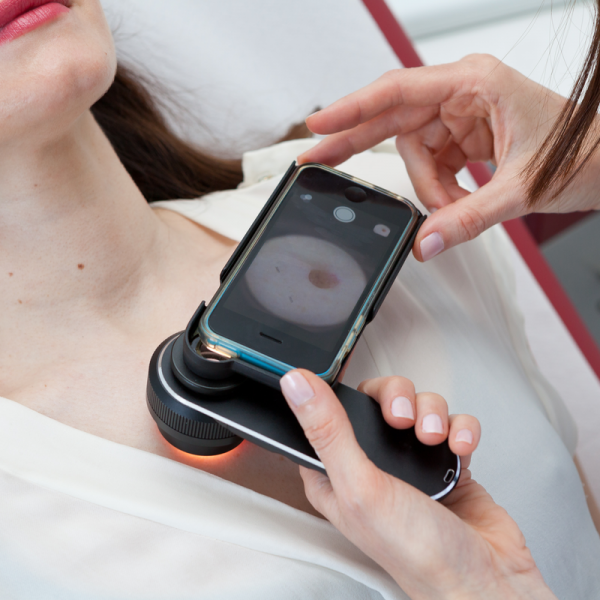
What is Bowen's disease?
Bowen's disease, also known as dermatosis praecancerosa, is a precursor to white skin cancer and requires early treatment. The disease often appears as a reddish scaly skin change and can develop in many different places and sometimes also affects the mucous membranes. Men over the age of 40 are more likely to suffer from Bowen's disease than men. Bowen's disease is often mistakenly diagnosed as psoriasis.
Is Bowen's disease malignant?
Bowen's disease describes the preliminary stage of white skin cancer, in this case a so-called squamous cell carcinoma. A squamous cell carcinoma is a malignant tumour that originates from the mucous membranes and the uppermost cell layer, the so-called epithelium, of the skin. In Bowen's disease, the tumour is still localised in its growth and has not yet grown beyond the basement membrane.
What are the causes of Bowen's disease?
There are various causes that can explain the development of Bowen's disease. In addition to general cancer-causing factors such as UV radiation or contact with carcinogenic chemicals, the use of immunosuppressive drugs can also contribute to the development of the disease.
What is Queyrat's erythroplasia?
If Bowen's disease develops in the mucous membranes or transitional mucous membranes, doctors call it erythroplasia quéyrat. This can affect the oral mucosa, the anal region, but also the glans and the foreskin of the penis.
Erythroplasia Queyrat is easily damaged skin that tends to bleed quickly and turn into a malignant carcinoma. Because this disease cannot always be surgically removed due to the sometimes difficult-to-reach parts of the body, erythroplasia Queyrat is often treated with radiation therapy.
How can Bowen's disease be prevented?
Doctors advise avoiding direct contact with UV radiation, as this is considered one of the main causes of Bowen's disease. Protective clothing, but also the use of sunscreen and strict avoidance of strong sunlight around midday can already help.
It is also advisable to get vaccinated against the human papilloma virus, which is also known to cause Bowen's disease. In addition to preventing Bowen's disease, the vaccination should also protect against the development of various types of warts and cervical cancer.
What are the symptoms of Bowen's disease?
In most cases, Bowen's disease is only visible as a change in the skin, but otherwise does not cause any pain or discomfort. On the outside, individual, but sharply defined red scaly skin changes can be noticed, which are a few millimetres to decimetres in diameter. Cowen's disease can be felt as a slight elevation. In most cases, Bowen's disease develops on the face, neck, upper body, hands or lower legs, but it can generally occur on any part of the body.
In many cases, Bowen's disease is initially misdiagnosed as eczema or psoriasis. However, after treatment with cortisone-containing preparations, the disease does not heal. Instead, symptoms such as skin redness or itching develop, which hardens the suspicion of Bowen's disease.
How is Bowen's disease diagnosed?
Patients who recognise Bowen's disease as a painless skin condition usually wait until it is too late to have it diagnosed by a specialist. However, it is important to see a doctor early to prevent Bowen's disease from turning into white skin cancer. To diagnose the disease, a reflected-light microscope, a so-called dermatoscope, can be used. Furthermore, a tissue sample (biopsy) can be taken under local anaesthesia to diagnose the disease with certainty through laboratory testing.
How dangerous can Bowen's disease become if it is not treated?
If Bowen's disease is diagnosed early, there is little risk that the disease could lead to complications. However, if Bowen's disease remains undetected for a long time, there is a risk of it degenerating into malignant white skin cancer. It is therefore advisable to have all types of skin changes clarified by a dermatologist at an early stage.
How is Bowen's disease treated?
Bowen's disease should be removed quickly, if possible. There are various treatment options available for this:
- the affected area of skin is cut out under local anaesthetic,
- laser therapy, in which a high-precision laser is used to cause tiny tissue injuries in order to stimulate the malignant cells to die,
- photodynamic therapy, in which the affected area of skin is treated with a light-sensitive agent and then irradiated with a so-called photosensitiser,
- cryotherapy, in which malignant cells are killed by extreme cold or targeted icing,
- by means of local treatment with chemotherapeutic agents, which can be administered in the form of infusions.
Which treatment method makes the most sense in each individual case depends on the size, but also the nature of the disease. In the case of surgery, usually only an outpatient treatment is necessary, which only takes a few minutes and can already be carried out under local anaesthesia.
What is the prognosis for Bowen's disease?
If Bowen's disease is treated in time, the chances of recovery are good. However, it is possible that Bowen's disease will manifest itself as a malignant carcinoma after a few years or decades.
If Bowen's disease is not treated at all, in about 30 to 50 percent of all patients it will develop into a more invasive form of tumour, which will spread metastases into the lymphatic system and spread tumour tissue throughout the body. In the case of metastasis, the 5-year survival rate is only 25 to 50 percent. It is therefore advisable in any case to have skin changes clarified by a specialist at an early stage.
